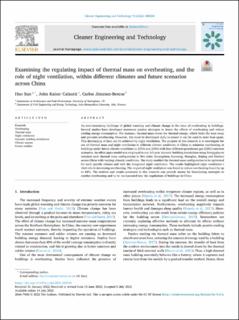| dc.contributor.author | Sun, Hao | |
| dc.contributor.author | Calautit, John Kaiser | |
| dc.contributor.author | Jimenez-Bescos, Carlos | |
| dc.date.accessioned | 2023-03-23T09:46:20Z | |
| dc.date.available | 2023-03-23T09:46:20Z | |
| dc.date.created | 2022-08-18T15:22:06Z | |
| dc.date.issued | 2022 | |
| dc.identifier.citation | Cleaner Engineering and Technology. 2022, 9 . | en_US |
| dc.identifier.issn | 2666-7908 | |
| dc.identifier.uri | https://hdl.handle.net/11250/3060066 | |
| dc.description.abstract | An ever-increasing challenge of global warming and climate change is the issue of overheating in buildings. Several studies have developed numerous passive strategies to lessen the effects of overheating and reduce cooling energy consumption. For instance, thermal mass stores the thermal energy, which locks the heat away and prevents overheating. However, this must be discharged daily to ensure it can be used to store heat again. This discharging of heat can be achieved by night ventilation. The purpose of this research is to investigate the use of thermal mass and night ventilation in different climate conditions in China to minimise overheating in buildings under future climate conditions in 2050s and 2080s with four different greenhouse gas (GHG) emission scenarios. An office space model was employed to run full-year dynamic building simulations using Energyplus to simulate each thermal mass configuration in five cities (Guangzhou, Kunming, Shanghai, Beijing and Harbin) across China with varying climatic conditions. The study enabled the thermal mass configuration to be optimised for each specific climate and with the integrated night ventilation. The results highlighted night ventilation’s vital role in decreasing overheating. The impact of night ventilation was found to reduce overheating hours by up to 60%. The method and results presented in this research can provide means for formulating strategies to combat overheating and to be incorporated into the regulations of buildings in China. | en_US |
| dc.language.iso | eng | en_US |
| dc.publisher | Elsevier | en_US |
| dc.relation.ispartofseries | Cleaner Engineering and Technology; | |
| dc.rights | Navngivelse 4.0 Internasjonal | * |
| dc.rights.uri | http://creativecommons.org/licenses/by/4.0/deed.no | * |
| dc.title | Examining the regulating impact of thermal mass on overheating, and the role of night ventilation, within different climates and future scenarios across China | en_US |
| dc.type | Peer reviewed | en_US |
| dc.type | Journal article | en_US |
| dc.description.version | publishedVersion | en_US |
| cristin.ispublished | true | |
| cristin.fulltext | original | |
| cristin.qualitycode | 1 | |
| dc.identifier.doi | https://doi.org/10.1016/j.clet.2022.100534 | |
| dc.identifier.cristin | 2044289 | |
| dc.source.journal | Cleaner Engineering and Technology | en_US |
| dc.source.volume | 9 | en_US |
| dc.source.issue | 9 | en_US |
| dc.source.pagenumber | 12 | en_US |

